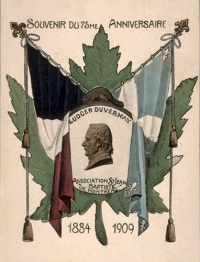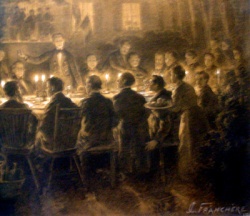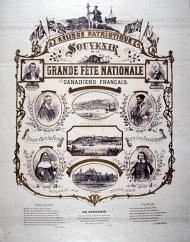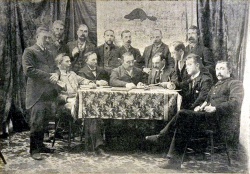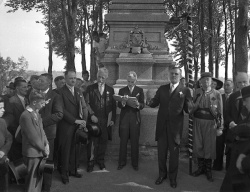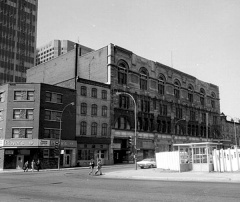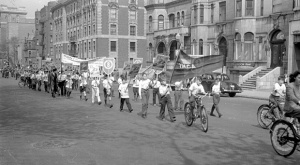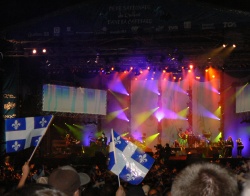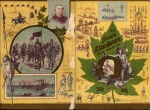Saint-Jean-Baptiste Society Network: from French-Canadian Unity to Quebec Nationalism
par Traisnel, Christophe
The Réseaux des Sociétés Saint-Jean-Baptiste [Network] has always been at the front lines of the various movements for claiming and affirming French Canadian identity and language rights (and more recently those of French-speaking Quebeckers) . Founded in 1854, this network, which is an offshoot of the Montreal Saint-Jean-Baptiste Association, has helped to forge the legends and symbolism associated with the shared history of French-speaking North Americans, a group that includes not only communities of Canadian origin, but also groups composed of U.S. Acadian emigrants. The Network has held a leadership role in political, cultural and social circles for over 150 years. This is why the history of the network can be considered as being synonymous with the identity discussions that have marked the past of the various French-speaking communities in North American, particularly because the Society has played a key role in the development of French-Canadian heritage.
From a Local Banquet to a Pan-American Network
A report appearing in the La Minerve newspaper dates the founding of the Montreal branch of the Saint-Jean-Baptiste Society back to 1834. It all started during a banquet organized by reporter Ludger Duvernay, who brought together the dominant political figures of the era, among them were Jacques Viger, the Mayor of Montreal; Louis-Hippolyte La Fontaine, Member of the Quebec Legislative Assembly; George-Étienne Cartier; and E. B. O'Callaghan, the Director of the reformist newspaper, The Vindicator.
A Banquet for Saint-Jean-Baptiste Day
During the banquet, the various guests offered a series of toasts in favour of the Lower Canada Assembly's passing the 92 Resolutions proposed by Louis-Joseph Papineau's Patriot Party. The bill expressed the general population's grievances in respects to British colonial power. Newspapers reported that at this event the participants decided to make Saint-Jean-Baptiste Day a national holiday for all French Canadians, although no mention of creating a Saint-Jean-Baptiste society was made at that time. It would seem therefore that the inauguration of Saint-Jean-Baptiste Day as a French-Canadian national holiday preceded the founding of the Society itself. In fact the society didn't officially come into being until 1843, long after the period of agitation and rebellion that lasted from 1834 to 1838, which also included the ensuing era of repression suffered by the "patriots." This explains why we usually speak of the founding of the Saint-Jean-Baptiste Society as having occurred during the 1834 banquet, an event which was incidentally immortalized by a painter who carefully recreated the founding moment on canvas. The painting can be found in the current headquarters of the Saint-Jean-Baptiste Society of Montreal, hanging in the VIP area of Ludger Duvernay House on Sherbrooke Street.
A French-Canadian National Holiday
The idea of making June 24th the French-Canadian national holiday caught on more quickly than Ludger Duvernay's proposal to establish societies throughout Lower Canada that would support the reforms desired by a large number of the colony's inhabitants. Subsequently, the disturbances of 1837-1838, the exile of the reformers, as well as their conviction or incarceration interrupted this movement without actually suppressing it altogether. Once the storm subsided, the June 24th celebrations took up where they had left off. However, it seemed that the anti-establishment veneer that had characterized the launching of the movement had disappeared once and for all. In 1837, the Church condemned the patriots' revolt and when the Saint-Jean-Baptiste festivities were reborn in 1842, they were organized under the patronage of the Catholic Church, which controlled the holiday celebrations and lent the entire event a religious dimension. At the time, the activities took on form of immense processions, which were later to be known as Saint‑Jean-Baptiste Day parades. At the same time, the temperance movement was in full swing, and so, it was decided that this celebration of French-Canadian identity should bear the marks of a more educational rather than an anti-establishment event. Thus the parades tended to close with a high mass that was intended to consecrate the communion of a Catholic French-speaking people.
A Network of Societies
From the very moment it was founded in 1843, the Saint-Jean-Baptiste Association sought to foster links of community solidarity among all French Canadians, with the Saint-Jean-Baptiste Day holiday functioning as an eloquent community demonstration of unity. The objective was to demonstrate and affirm the role and power of French-speaking Canadians in North America. The Association's initial role was to offer mutual assistance and facilitate charitable acts as a means of "making society better"-which was how they phrased their mission statement in the language of the day. The Society of that time began to work to establish itself as an institution, assembling most of Montreal's notable French-Canadian public figures who "formed a society," in the literal sense of the term. This gathering together of major movers and shakers paved the way for the Association to become a mutual assistance network in the community, as well as an influential, tightly-organized, political society. Political and social circles began to mingle and from the 1850s on, a network extending beyond Montreal began to develop. Chapters of the Saint-Jean-Baptiste Society were founded initially in Canada, then in New England, and finally in Louisiana. This expansion was accompanied by a diversification of activities and a certain competition among the various federations in charge of coordinating the networks in Quebec, the rest of Canada, and the United States.
Shared Memory, Mutual Assistance and Mobilization
As this network of societies began to spread across North America, it particularly began to concentrate its efforts in three main areas, all of which would have a decisive influence on the developing identity of the community, as well as on how its shared history would be presented and on the commemorative aspects related to the French-speaking community.
On one hand, the network very often took charge of commemorative initiatives related to the discovery or rediscovery of French Canada's shared history by coming up with ways to rally the general populace around events celebrating French-Canadian identity. For instance, the discovery of bones dating back to the 1760 Battle of Sainte-Foy (the last victory won by French troops in North America) led to a solemn burial ceremony organized by the Saint-Jean-Baptiste Society of Quebec City on June 5th, 1854. In this way, numerous chapters of French-Canadian history were appropriated by the various Saint-Jean-Baptiste societies and were sometimes transformed into commemorations of French-Canadian shared memories or memorial sites. In so doing, the network helped uncover historical heritage that would subsequently be taught and transmitted over several generations, thereby helping to develop and sustain, if not create anew, shared (historic) memories for the French-Canadian community. This activity of recovering tangible elements attesting to the community's past would very often be accompanied by a distribution of brochures, almanacs, historical works and articles that helped increase public knowledge of these historical rediscoveries, most of which involved interpretations favourable to the cause of French-Canadian nationalism.
On the other hand, as of the mid 19th century, a very tangible cooperative aid initiative that was based on the principle of mutual assistance for the benefit of French Canadians took shape around the Saint-Jean-Baptiste societies in operation in the various dioceses. The goal was to strengthen bonds of mutual assistance within the communities, especially through fund-raising activities and the founding of insurance companies. In this way a culture of community assistance was firmly established, thereby setting the stage for the ensuing rise of the cooperative movement. As these mutual-assistance initiatives took hold, the various Saint-Jean-Baptiste Society chapters sought to maintain links of solidarity among all North American French speakers, especially by initiating large rallies in Montreal and other communities intended to influence political activities centred in the St. Lawrence Valley, as well as throughout the Province of Quebec. This often literally involved mobilising North-American French-Canadian society in its entirety.
The Society's third main role was to consolidate and distributed the various resources necessary for ensuring the ongoing success of its commemorative and community aid activities. And so, the network would be responsible for organising the meetings involving the various chapter representatives, as well as for raising enough funds, so as to guarantee the efficient ongoing operation of the Society as a whole. Thus, subscriptions, bazaars, lotteries and campaigns to collect funds and bequests were organized across the province, as ever more defined demonstrations of community vitality and solidarity.
The Saint-Jean-Baptiste Society strengthened its role as the representative of North-American, French-Canadian Catholic interests and identity by spearheading mutual-assistance and commemoration endeavours. Its initiatives would thereafter be intimately involved in the ongoing process of constructing (and developing) Montreal's tangible heritage assets, particularly by assisting with the funding and construction of the Monument-National at the end of the 19th century (which was a particularly laborious undertaking), as well as with the erecting of the Mount Royal Cross in 1924. This community heritage-building process gave rise to immense processions. For instance, the inauguration of the Mount Royal Cross was an occasion for an impressive demonstration of French-Canadian community vitality, in which a glorified version of French cultural history in North America was presented to the public by way of various allegorical floats. As a result, the various parades, processions, gatherings and commemorations have all come to mark the various major events in the history of the Society. These events often rallied large crowds that displayed a keen sensitivity to current events, which affected the diverse minorities in French-speaking North America, particularly those in Western Canada. By offering its unreserved praise in support of the events, the press has obviously participated in the movement, acting as a sort of amplifier for the entire community's enthusiasm and vitality. Thus, over the years the various Saint-Jean-Baptiste Society chapters have played a key role in uncovering even promoting French-Canadian heritage all across Canada.
From French-Canadian to Quebec Nationalism
Le Mouvement National des Québécois (MNQ)
Given the scope of the network, its importance and its community vocation, it became necessary to coordinate certain collective activities and organise partnerships among the various Society chapters. And so, this particular issue was regularly addressed at the conventions that brought together those in charge of the various local chapters, whether they were Canadian or American. These conventions were additional opportunities for developing a public forum in which French-Canadians could freely exchange ideas and express themselves. As a result, at the end of World War Two, an effort was made to establish a federation of Saint-Jean-Baptiste Society chapters. After the first attempt to federate with the Ontario chapters in 1945 ended in failure, the Quebec Federation of Saint-Jean-Baptiste Societies was created in 1947. This event reflected the fact that Quebec French speakers, which were a majority in their home province, had long been distancing themselves from minority French-speaking communities across the rest of Canada. It was a process that would culminate in 1966, with a de facto rupture at the States-General of French-Canada, a French-speaking general assembly that was largely organized by the Saint-Jean-Baptiste network. As soon as it was created, the Quebec Federation became involved in a mobilization campaign intended to convince the provincial government to adopt the Fleurs-de-Lys flag as the symbol of Quebec. It also began to contemplate the development and promotion of the identity of French-speaking Quebec, as well as its survival. As it rallied followers to defend the cause, in 1958, it also began put forth the idea of an entirely Quebec education ministry-a dream which became a reality in 1964.
During the 1960s, the Quebec Federation of Saint-Jean-Baptiste Societies, particularly its Montreal chapter, went one step further and expressed its support for the sovereignty vote in referendum that was being contemplated in Quebec at that time. As a matter of fact, starting in 1969, the entire Federation began to take sides with sovereignty movement, along with the majority of Society chapters (including that of Montreal). As a result, they joined the Front du Québec Français, which was founded that same year, and subsequently the federation became an integral part of the Mouvement Québec Français, which defended the idea of a law establishing French as Quebec's only official language. This was a watershed decision for the Federation, although it did not receive anything resembling unanimous approval; indeed a number of local chapters that rejected this change of direction and began to split with those committed to this political orientation. A few years later, in 1972, the Federation initiated a "shift in favour of identity," in keeping with the secularisation movement affecting Quebec's public institutions across the board. It even changed its name, becoming the Mouvement National des Québécois (MNQ), thereby sanctioning the idea of Quebec as nation and a people apart. The MNQ would henceforth actively engage in all discussions concerning French-language issues, as well as those of nationhood. Furthermore, it was involved in mobilising support for the enhancement the status of French speakers in Quebec, particularly endeavours that promoted political independence. And the opportunity to do so was particularly great during the two referendums on Quebec sovereignty that were held in 1980 and 1995.
The Quebec National Holiday
In 1984, the MNQ entered an institutional development phase that was a direct result of the Quebec government deciding to entrust it with an important commemorative purpose, i.e. to coordinate all events for celebrating Quebec's national holiday throughout the province. The MNQ, an umbrella organisation that brought together all of Quebec's pro-sovereignty Saint-Jean-Baptiste Society chapters into one federation, as well as certain number of newly created local chapters with nationalist vocations, helped to bring about a gradual "nationalization" and "Quebecisation" of a holiday that had conversely always been known to the federal government as official holiday of all "Canadians of French expression." The Montreal chapter of the Society still organizes the city's Saint-Jean-Baptiste Day parade, which, over the years, has become a popular parade down Notre-Dame Street that ends with a show in Maisonneuve Park. A mass commemoration of the holiday's religious origins still takes place before festivities begin and the event usually closes with a large-scale televised concert.
In addition to organizing the national holiday, the Saint-Jean-Baptiste Society of Montreal has also spearheaded a number of initiatives, including the 1944 establishment of the Prêt d'Honneur program, which is intended to help young French-Canadians of modest means pay for their studies by way of a loan service for those seeking a career in fields related to science or technology. The initial goal of this program was to train anelite that could in turn ensure the growth and development of the French-Canadian people. The Montreal chapter also helped to organize the States-General of French-Canada held in 1966 and, more recently, to create the Maison des Étudiants, in 2001.
Hence the Saint-Jean-Baptiste Society network has played a key role in French-Canadian heritage development in three different ways: 1) through its mutual assistance initiatives which have helped French-Canadian society discover the financial leverage it has at its disposal; 2) through its commemorative and symbolic activities that have discovered or, in some cases, helped develop a number of entirely new elements of French-Canadian heritage; and 3) last but not least, through its continued support of political activities that have helped spawn language- and identity-related activisim that in turn have sometimes proven to be crucial in determining the future of the French-Canadian, as well as that of communities of French-speaking Quebecois.
Christophe Traisnel
Researcher, Canadian Institute for Research on Linguistic Minorities
BIBLIOGRAPHY
Levine, Marc V., La reconquête de Montréal, Montréal, VLB éditeur, 1997 [1990], 404 p.
Mouvement national des Québécois, Aide-mémoire pour les souverainistes, brochure, Montréal, MNQ, juin 1994, 55 p.
Mouvement national des Québécois, Et si on lançait des fleurs à... Lise Payette et Gilles Vigneault, brochure, Montréal, MNQ, 2000, 30 p.
Mouvement national des Québécois, Et si on se lançait des fleurs, rapport annuel, Fête nationale 2001, Montréal, MNQ, novembre 2001, 36 p.
Mouvement national des Québécois, Et si on se lançait des fleurs? Guide de la fête nationale du Québec 2002, Montréal, Mouvement national des Québécois, brochure, 2002, 24 p.
Mouvement national des Québécois, Fête nationale du Québec, Guide d'activités, brochure, MNQ, 1998, 92 p.
Mouvement national des Québécois, Présentation, Montréal, MNQ, 2e trimestre 1991, 10 p.
Rumilly, Robert, Histoire de la Société Saint-Jean-Baptiste de Montréal : des patriotes au fleurdelisé, 1834-1948, Montréal, L'Aurore, 1975, 564 p.
Société Saint-Jean-Baptiste de Montréal, 1999, Sommet de la Francophonie, La grande francophonie canadienne ou l'imposture d'Ottawa, septembre 1999, 16 p.
Société Saint Jean-Baptiste de la Mauricie, Société Saint-Jean-Baptiste de la Mauricie, brochure, non daté, 12 p.
Additional DocumentsSome documents require an additional plugin to be consulted
Images
-
 Arbre généalogique de
Arbre généalogique de
s Présidents de... -
 BAnQ, carte postale.
BAnQ, carte postale.
Titre : S... -
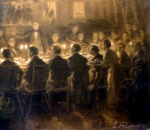 Banquet de fondation
Banquet de fondation
de la Société S... -
 Char allégorique "Bie
Char allégorique "Bie
n être" tiré pa...
-
 Enfants participant a
Enfants participant a
u défilé de la ... -
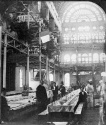 Intérieur du Crystal
Intérieur du Crystal
Palace décoré p... -
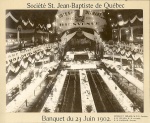 Intérieur du Quebec S
Intérieur du Quebec S
kating Rink - B... -
 La grande fête nation
La grande fête nation
ale à Québec ...
-
 La procession de la S
La procession de la S
aint-Jean-Bapti... -
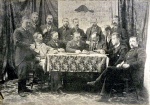 Les officiers de la S
Les officiers de la S
ociété Saint-Je... -
 Relique patriotique -
Relique patriotique -
Grande fête na... -
 Université de Montréa
Université de Montréa
l, Collection B...
Vidéo
Documents sonores
-
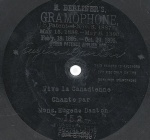 La paix des braves
Interpreter : Samian / Loco Locass.
Writer : Gilles Moar, Mathieu Fahoud Dionne, Sébastien Fréchette, Sébastien Richard, Samuel Tremblay.
Album : Face à soi-même, 2007.
La paix des braves
Interpreter : Samian / Loco Locass.
Writer : Gilles Moar, Mathieu Fahoud Dionne, Sébastien Fréchette, Sébastien Richard, Samuel Tremblay.
Album : Face à soi-même, 2007.
-
 Le Québécois (live)
Interpreter : Jacqueline Lemay.
Writer : Jacqueline Lemay.
Album : La mémoire des Boîtes à chansons, 1996.
Le Québécois (live)
Interpreter : Jacqueline Lemay.
Writer : Jacqueline Lemay.
Album : La mémoire des Boîtes à chansons, 1996.
-
 Le Référendum
Interpreter : Jean Lapointe.
Writer : Jean Lapointe, Marcel Lefebvre.
Album : 15 ans d’émotion en 21 chansons, 1977.
Le Référendum
Interpreter : Jean Lapointe.
Writer : Jean Lapointe, Marcel Lefebvre.
Album : 15 ans d’émotion en 21 chansons, 1977.
-
 Québécois de souche
Interpreter : Les Cowboys Fringants.
Writer : Jérôme Dupras, Dominique Lebeau, Marie-Annick Lépine, Jean-François Pauze, Karl Tremblay.
Album : Motel Capri, 2000.
Québécois de souche
Interpreter : Les Cowboys Fringants.
Writer : Jérôme Dupras, Dominique Lebeau, Marie-Annick Lépine, Jean-François Pauze, Karl Tremblay.
Album : Motel Capri, 2000.
Documents PDF
-
 Extrait du compte-rendu de la cérémonie de translation des restes des Braves de 1760
Extrait du compte-rendu de la cérémonie de translation des restes des Braves de 1760
-
 Fête de la Saint-Jean-Baptiste au Massachusetts
Fête de la Saint-Jean-Baptiste au Massachusetts
-
 Illumination de la Croix du Mont-Royal
Illumination de la Croix du Mont-Royal

